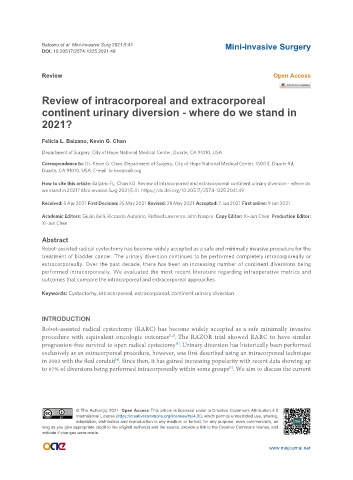Page 404 - Read Online
P. 404
Balzano et al. Mini-invasive Surg 2021;5:41 Mini-invasive Surgery
DOI: 10.20517/2574-1225.2021.49
Review Open Access
Review of intracorporeal and extracorporeal
continent urinary diversion - where do we stand in
2021?
Felicia L. Balzano, Kevin G. Chan
Department of Surgery, City of Hope National Medical Center, Duarte, CA 91010, USA.
Correspondence to: Dr. Kevin G. Chan, Department of Surgery, City of Hope National Medical Center, 1500 E. Duarte Rd,
Duarte, CA 91010, USA. E-mail: kchan@coh.org
How to cite this article: Balzano FL, Chan KG. Review of intracorporeal and extracorporeal continent urinary diversion - where do
we stand in 2021? Mini-invasive Surg 2021;5:41. https://dx.doi.org/10.20517/2574-1225.2021.49
Received: 5 Apr 2021 First Decision: 25 May 2021 Revised: 28 May 2021 Accepted: 7 Jun 2021 First online: 9 Jun 2021
Academic Editors: Giulio Belli, Riccardo Autorino, Richard Lawrence John Naspro Copy Editor: Xi-Jun Chen Production Editor:
Xi-Jun Chen
Abstract
Robot-assisted radical cystectomy has become widely accepted as a safe and minimally invasive procedure for the
treatment of bladder cancer. The urinary diversion continues to be performed completely intracorporeally or
extracorporeally. Over the past decade, there has been an increasing number of continent diversions being
performed intracorporeally. We evaluated the most recent literature regarding intraoperative metrics and
outcomes that compare the intracorporeal and extracorporeal approaches.
Keywords: Cystectomy, intracorporeal, extracorporeal, continent urinary diversion
INTRODUCTION
Robot-assisted radical cystectomy (RARC) has become widely accepted as a safe minimally invasive
[1,2]
procedure with equivalent oncologic outcomes . The RAZOR trial showed RARC to have similar
[3]
progression-free survival to open radical cystectomy . Urinary diversion has historically been performed
exclusively as an extracorporeal procedure, however, was first described using an intracorporeal technique
[4]
in 2003 with the ileal conduit . Since then, it has gained increasing popularity with recent data showing up
to 97% of diversions being performed intracorporeally within some groups . We aim to discuss the current
[5]
© The Author(s) 2021. Open Access This article is licensed under a Creative Commons Attribution 4.0
International License (https://creativecommons.org/licenses/by/4.0/), which permits unrestricted use, sharing,
adaptation, distribution and reproduction in any medium or format, for any purpose, even commercially, as
long as you give appropriate credit to the original author(s) and the source, provide a link to the Creative Commons license, and
indicate if changes were made.
www.misjournal.net

